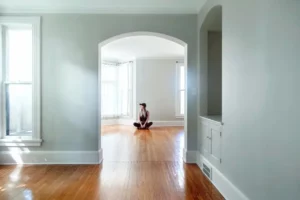When you are moving into a new accommodation, there is an unmissable step that will ensure you get your deposit back (or at least, to have the proof to get it back): the inventory of fixtures.
Whether it’s done when you are coming in or when you are leaving, the inventory of fixtures is a specific document that stocktakes everything that is in your new home. It is mainly done when the keys are delivered to the tenant. It enables to prove any damages or modifications caused by the aforesaid tenant. These two types of inventories are quite similar : the incoming inventory of fixtures testifies the initial state of the apartment before the new tenant comes in. On the other hand, the outgoing inventory of fixtures is made to attest the condition of the apartment after the passing of the resident.
In flat sharing, the inventory of fixtures are the same, on paper but all the residents have to be reunited while revising the home and signing the lease contract. We therefore proceed with a collective inventory. If one or more tenants can not attend the inventory of fixtures, they can lean on representatives. They can either be a law enforcement official such as a bailiff or a close relation such as a friend, a family member or a partner. A power of attorney should be emitted and signed by the representative and the housemate. Many templates are findable on the internet.
The incoming inventory of fixtures
The incoming inventory of fixtures is mandatory when you are coming into your new home. Whether it is rented furnished or not, it must be done at the same time as the key deliveries. It also must be signed by all the parties : landlord or lessor of the good, the commissioned person and the tenant or its representative. If all the roommates are moving in at the same time, they all must be there. On the contrary, if they move in at a different time, they are not obliged to attend the inventory of fixtures of the other tenants.
The incoming inventory of fixtures is made to assess the whole accommodation and attest of its initial condition. Its operation is very simple. During the inventory of fixtures in house sharing, it is necessary to go around the whole apartment, or the house, to attest of minor (or not) carelessness present before moving in. In apartment-sharing, it is important to make a difference in the inventory of shared parts and private parts. Both parts (lessor and tenant) can take pictures of the home. This is highly recommended.
The incoming inventory of fixtures never goes alone. It must be coupled with the outgoing one.
The outgoing inventory of fixtures
The outgoing inventory of fixtures is done at the end of the tenant’s lease contract, when you are leaving the shared apartment. Indeed, as previously written, if the incoming inventory of fixtures shows the state of the accommodation before the incoming of the tenants, the outgoing inventory of fixtures is made to notify of any damages caused by the current tenant. So, it is mandatory to inspect every inch of the accommodation and bedrooms, mostly the following alertness spots :
- the floor
- the ceiling
- kitchen units, cabinet, and shelves
- furnitures (if the accommodation is rented furnished)
- pipeworks and water drainages
- electricity, lighting and household appliances (hotplate, burner, etc.)
As the incoming inventory of fixtures, this one must be attended by the lessor, the landlord, the tenant(s) who is leaving or their representatives.
The outgoing inventory of fixtures can be done in many ways, depending on the number of roommates that are leaving the accommodation and the type of lease contract chosen. The French ALUR law, revising the legislative text of July, 6th 1989, establishes some rules and holds sway over lease contracts :
- When multiple lease contracts have been signed by all the tenants, the outgoing one is not mandatory if only one of them is leaving, but this is recommended.
- On the other hand, when a single-lease agreement is linking all of the tenants, the inventory of fixtures is necessary because this type of contract resembles an individual lease contract.
By processing the making of the inventory of fixtures, it is essential to determine if damages occurred. They are decisive when the time of the contract’s termination comes, and with it, the restitution of the whole deposit (or not). If the move-out inspection goes smoothly, then your deposit will be refunded within 60 days or 2 months after it.
In which conditions can a holdback be done ?
In some situations, the deposit can not be fully given back to the tenant. Many reasons can be the conjured cause, such as leaving the apartment in a bad state. The tenant is bound to maintain the apartment as if it was his/her. (S)He has to do the little renovation / maintenance work that falls to him/her : floors and pipeworks maintenance, paintings refreshments, door handles replacement, etc. The landlord / lessor can not engage a holdback on the deposit without justifying it. That’s why incoming and outgoing inventories of fixtures are that important.
Another key motive of the non-restitution of the security deposit involves outstanding debts. Whether it is from one or many of the roommates, this case is not an isolated one. Unfortunately, outstanding debts do not only have a consequence on the bad payer. Depending on the type of the lease contract, it can have an impact on each of the roommates and can mishandle the relationship between them. The roommates could even face an assignment from the Departmental Conciliation Committee, an authority acting as mediator between the tenants and the lessor to come to an amicable agreement.
This solution may not end the feud so the owner can appoint a formal notice of the concerned tenant(s). To avoid this situation, discover our tips to get on well with your roommates.
As previously written, to justify the substitution of a part of the security deposit, there is a need of proof, no matter the reason. For this, the landlord can add various items to complete the file : pictures or videos of the carelessness, bills, reminder letters or every kind of complaint letter sent to the roommates.
The main points to check on your side
As a tenant, here are all our tips to reduce the risk of non-restitution of your security deposit :
- Refurbish the walls
If you have made small changes, such as installing picture frames or painting a wall to personalize your home a bit more and to make it feel more comfortable, make sure you refurbish the walls before leaving. Fill in any holes and do not forget to paint the wall. Make sure to check with your landlord beforehand if they don’t want to keep the wall color. You never know 😉
- Keep a particular attention to the already there items
Whether your home is furnished or not, there are certainly elements present such as the kitchen which is often equipped. Make sure to take care of it, to clean the hotplates with adapted products, and to regularly clean your household appliances as well as the cupboards. All of this is made available to you, so please take care of it.
- Maintain your interior space in order
In general, you should maintain your home clean and all the equipment installed as if you owned it. Are the bathroom seals getting damaged? Talk to your landlord and redo them. Do your shutters squeak? Don’t forget to grease them! And last but not least, the maintenance of your boiler is also your responsibility. To make it easier, find the complete list of repairs and rental maintenance.
Is the inventory of fixtures necessary when roommates change ?
Apartment sharing is known for its roommates coming and going. If looking for a new roommate is sometimes tedious, the goodbyes are also difficult. In case of departure of one or more roommates, the type of lease signed will determine whether it is mandatory or not to establish an inventory of fixtures:
- Individual lease to each roommate: a new lease has been established, so it is essential to make a new inventory of fixtures upon the arrival of the new roommate.
- Single lease to all roommates: the incoming roommate is not required to make a new inventory of fixtures. However, it is strongly recommended.
Even if it is not a legal requirement, it is essential to carry out incoming and outgoing inventories of fixtures. They will allow the new tenant not to be held responsible for any damage that may have been caused previously and will justify the payment of the security deposit.
How does a coliving inventory of fixtures work ?
If you also want to try out communal living but are uncomfortable with certain aspects of sharing a house with other people, discover coliving now! Coliving is based on the same principles as apartment sharing without the disadvantages and with additional services.
Indeed, you are sharing your home with several other colivers, but you have an individual lease contract, which means that you keep your independence, whether it is financial or physical. You have your own private space, consisting of a bedroom (and sometimes a bathroom and a kitchenette when the configuration allows it). Your rental contract is individual, and that’s the difference with a traditional apartment sharing. Coliving reduces expenses because your rent is an all-inclusive package! Way simpler for the administrative procedure, you will not depend on the other tenants on several points, in particular the inventory of fixtures:
It will not have any incidence on that of your colivers (yes, it is the nickname which one gives to the occupants of a housing in coliving). You rent your bedroom (private part) and the common parts. It’s better for your landlord, but it’s also simpler for you. You have your own lease, as if you were in a traditional rental. Therefore, you are not subject to the solidarity clause included in most shared leases.
The inventory of fixtures is carried out in the presence of the landlord and the tenant in question. It is compulsory and makes you responsible for your private part, as well as for the common parts. At Colivys, everything is digitalized! Much faster, we take pictures of the different parts of the apartment when each tenant arrives. This way, we have a visual comparison when the time comes to make the inventory of fixtures at the end of the rental period.



